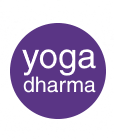PRASARITA PADOTTANASANA
Basic Alignment
Distance between feet: This depends on the student. The feet need to be at a distance to provide support for the posture
- Position of feet: Straight
- Hips: Over the heels (neutral pelvis)
- Hands: Under the shoulders with fingers spread
- Torso: Straight (neutral spine)

POINTS TO WATCH
Typical points to be aware of are:
- The hips sit back behind the heels
- The feet are not straight
- The weight rests on the outer edges of the feet, with the arches lifting
- The inner thighs (adductors) not engaging with the arches collapsing
JOINTS TO WATCH
Ankle joint:
- The ankle is a hinge synovial joint primarily designed to flex and extend
- The ankle is stabilised by ligaments and tendons
- Tendons link muscle to bone. They allow us to move our limbs, they prevent injury by absorbing shock, and act as stabilisers
- Ligaments link bone to bone. They act as joint stabilisers, prevent excessive movement and allow for normal motion
- Ligaments have proprioceptive cells which provide a sense of awareness of body position to increase balance and stability. When a ligament is injured balance and joint stability can be negatively affected

WATCH OUT!
- Standing to wide in this posture will tend to take the weight into the outer edges of the feet.
- This will push the ankles outwards and may stretch the lateral ligaments and tendons

MUSCLES TO WATCH
Hamstrings
Origin: Ischial tuberosity (sit bones)
Insertion: Knee
Action: Extend the hip and flex the knee. The Hamstrings are leg extensors, and help control a forward bend. When going forward they lengthen under tension (eccentric contraction)



WATCH OUT!
It’s easy to injure the Hamstrings when going into forward bends. Always look to feel the stretch in the body of the muscle (middle). Discomfort at the sit bones (origin) is a sign you are not stretching in the right place.
WATCH OUT!
Adductor Magnus
- Origin: The pubis and ischium bones
- Insertion: Mainly on the medial posterior surface of the femur
ACTION:
The function of the adductor muscles is to pull the thighs together and rotate the upper leg inwards, as well as stabilising the hip. The Adductor Magnus assists the Hamstrings in a forward bend.


WATCH OUT!
The Adductor Magnus has the same origin as the hamstrings and as a result will lengthen under tension (eccentric contraction)
